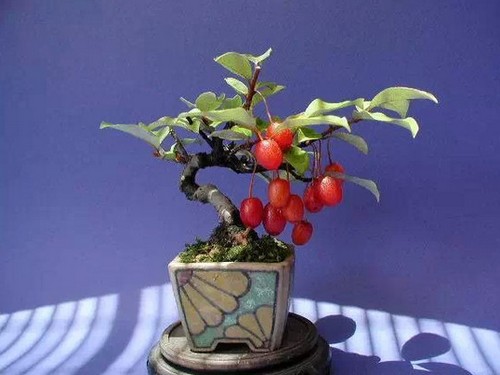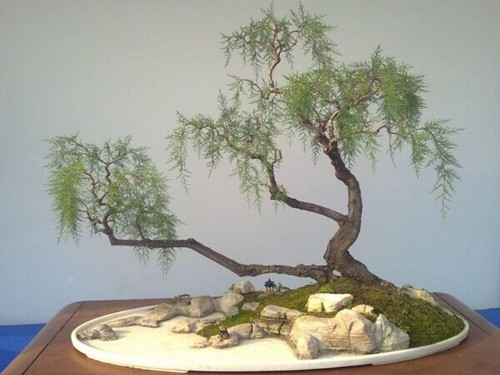Production Technology of Bonsai of Populus tomentosa
Euonymus tomentosa is an evergreen shrub or small tree of Euphorbiaceae. The trunk is gray and smooth, with dense branches and four-angled branches. Leaves opposite, leathery, entire, elliptic or Obovate, apex rounded or retuse, surface bright green, abaxially yellowish green. Flowers clustered in leaf axils or branch ends, blooming from April to May, flowers yellowish green. The main producing areas are Anhui, Zhejiang, Jiangxi and Hubei. The tree is graceful, which is not only an important tree species for hedge scenery, but also a precious tree species for bonsai production.

Draw materials:
First, bonsai is propagated by sowing or cutting, but it takes a long time to cultivate, and it is difficult to get good materials with roots and claws and vigorous Gucci. The second is to dig up the old pile. The excavation of old piles is better in summer, followed by spring and autumn, and the worst in winter. After excavation, the pile blank can be wrapped in plastic bags to moisturize the roots. When planting, it is necessary to remove the descending main root and cut off most of the leaves to prevent water loss and ensure survival. It can be raised in the open field first, or directly on the basin, but it must be cultivated for more than two years before it can be made.
Selection of basin:
The choice of basin can be Yixing purple sand basin or light glazed pottery basin. The shape and size of the basin can be determined according to the size and shape of the pile. In principle, the cliff type should be square or round thousand-cylinder basin, oblique dry type, curved dry type, jungle type, etc., and round, oval and rectangular basins should be used.
Use soil:
Potted soil small leaf yellow poplar likes fertile sandy loam, potted soil is better with fertile, loose, aerated and permeable sandy loam, and can also be mixed with slag 40%, rotten soil or vegetable garden soil 40%, and river sand 20%.
Put on the basin:
The best time for potting is between spring and summer. The excessively long and dense roots should be cut off when planting, and the roots can be modified to make the roots stretch naturally in the basin according to the needs of modeling. The depth of planting should not be too deep, after covering the soil with water, put it in a semi-shady place, keep the basin soil moist, spray water frequently to the leaf surface, and wait for about 30 days for the plant to grow, then it can be transferred to normal maintenance.
Water and fertilizer:
The leafy yellow poplar likes to be wet and needs to be watered frequently. The period from May to August is the peak growth period of Populus tomentosa, which can be combined with watering and applying thin rotten cake fertilizer for several times.
Trim:
Always pay attention to pruning overgrown branches, overlapping branches and extra branches that affect the shape of the tree. The fruit of Euonymus tomentosa should be picked in time so as not to consume nutrients.
Shape:
Modeling production should be based on the basic tree appearance of the plant, let nature take its course, and carry out artistic modeling. Modeling techniques can be cut, can be tied, but climbing in summer and autumn is the best, when the branches are more flexible, easy to bend; pruning should be carried out in spring. Although the germination ability of Buxus tomentosa is strong, "if there is no leaf, there is no hair". Therefore, no matter it is modeling or daily pruning, the method of "leaving leaves one by one and forcing the bud to sprout in short" can be adopted for the branches that are not in place, so that they can gradually sprout down and not blindly pursue one step in place.
Change the basin:
Generally speaking, the time for changing poplars in small and medium-sized poplars can be 2 to 3 years and once every 5 years. Plants with weak growth should be turned over in time. Combined with changing the basin, cut off some of the over-long and dense old roots, replace the new culture soil and replant.
Time: 2019-05-26 Click:
- Prev

The method of making Elaeagnus angustifolia bonsai
Elaeagnus angustifolia, alias semi-Chunzi, sweet mallet, sparrow crisp, goat milk, scientific name E.pungens, native to China, temperate and subtropical regions of the Northern Hemisphere, belongs to Elaeagnaceae evergreen shrubs. The fruit tastes sweet and edible when ripe. Roots, leaves and fruits are all used for medicinal purposes. Natural plant shape, flower fragrance and fruit red
- Next

The making method of strange willow bonsai
Tamarix branches are small, drooping, graceful, shaped like weeping willows; its torso is like iron, old and strange, with the quality of pine and cypress; it blossoms three times a year, the flowering period is longer, and the pink flowers are more enchanting; its roots, such as swimming dragons, are wonderful in shape, whether they are root, trunk, leaves or flowers.
Related
- Fuxing push coffee new agricultural production and marketing class: lack of small-scale processing plants
- Jujube rice field leisure farm deep ploughing Yilan for five years to create a space for organic food and play
- Nongyu Farm-A trial of organic papaya for brave women with advanced technology
- Four points for attention in the prevention and control of diseases and insect pests of edible fungi
- How to add nutrient solution to Edible Fungi
- Is there any good way to control edible fungus mites?
- Open Inoculation Technology of Edible Fungi
- Is there any clever way to use fertilizer for edible fungus in winter?
- What agents are used to kill the pathogens of edible fungi in the mushroom shed?
- Rapid drying of Edible Fungi

